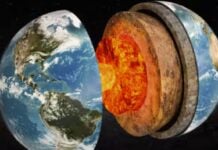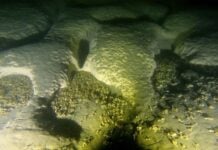
A bizarre dent in Earth’s magnetic field above the southern Atlantic Ocean weakens the southern lights, new research finds.
The South Atlantic Anomaly is a large, oval-shaped region over South America and the southern Atlantic Ocean where Earth’s magnetic field is weakest. The anomaly is already well known for allowing charged particles from the sun to dip close to Earth’s surface, exposing satellites orbiting above to high levels of ionizing radiation, according to NASA.
Now, a study published Feb. 8 in the journal Geophysical Research Letters finds that this weak region also affects the southern aurora, the glowing lights in the upper atmosphere that can be seen at high latitudes. The southern lights occur over and around Antarctica and are the equivalent of the northern lights that dance over the Arctic and Subarctic.
Auroras are caused by solar particles interacting with gas molecules in Earth’s atmosphere and are usually considered largely under the control of the sun, said Zhi-Yang Liu, first author of the study and a researcher at the Institute of Space Physics and Applied Technology at Peking University in China. But the new research highlights the two-way nature of the relationship.
“Our discovery highlights the significance of Earth-related factors, such as anomalies in Earth’s intrinsic magnetic fields that rotate with the Earth,” Liu said.
PROTECT YOUR HOME AND CAR WITH THE BEST LIGHTNING AND EMP PROTECTION AVAILABLE…
The researchers used data from an instrument aboard the FengYun-3E satellite, launched in 2021, that measures magnetic-field variations. They found a “substantial weakening” of magnetic fluctuations in the aurora australis, or southern lights, where it overlaps with the South Atlantic Anomaly.
To confirm the findings, they also analyzed ultraviolet light from this region of the aurora using data from the U.S. Defense Meteorological Satellite Program. This also showed a weakening in the southern lights in the area of the anomaly.
It’s likely that this weakening is even visible to the naked eye, Liu and study co-author Qui-Gang Zong, also of the Institute of Space Physics and Applied Technology, noted.

There are fewer auroras reported from China’s Great Wall Station and other research stations on King George Island than in other Antarctic regions, they said. Research suggests that the ultraviolet and visible light in auroras behave similarly, Liu said, so it’s likely that the visible light of the aurora is weakened by the South Atlantic Anomaly, too.
The weakened magnetic fluctuations of the anomaly seem to reduce the amount of energy that can be put into the atmosphere by solar particles, Liu said, but the physics of the weakened aurora is not entirely understood.
There may be feedback effects between the atmosphere and the solar energy that further complicate the picture. Future research will also investigate whether a similar phenomenon occurs on other planets, he said. [AGUPubs]
Hey friends, it’s time to wake up!
If a few more people choose to support my work, I could expose more lies, root out more corruption, and call out more hypocrites. So, if you can afford it, please support my endeavor by either using PAYPAL or the DonorBox below (PAYPAL & Credit Cards / Debit Cards accepted)…
If you are a crypto fanatic, I do now accept crypto donations:
BTC: 1AjhUJM6cy8yr2UrT67iGYWLQNmhr3cHef (Network: Bitcoin) USDT: 0x490fe5d79d044a11c66c013e5b71305af0a76c1b (Network: Etherum ERC20)
You should join my newsletter to get a daily compilation of different breaking news, pictures and videos… YOU WILL LOVE IT!
Thank you,
Manuel












